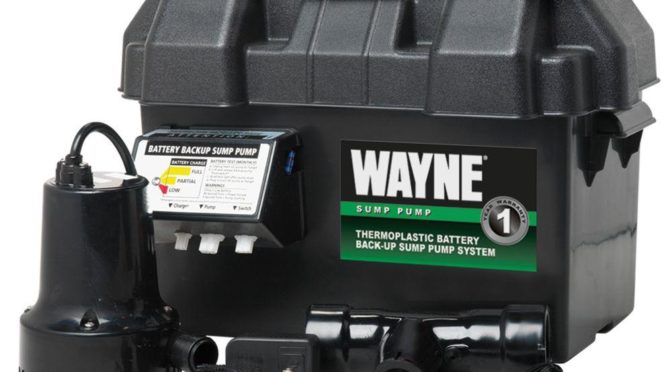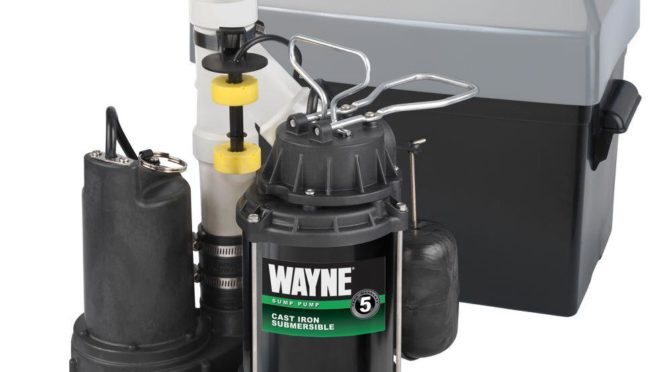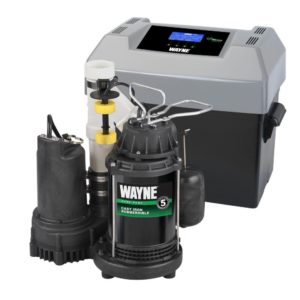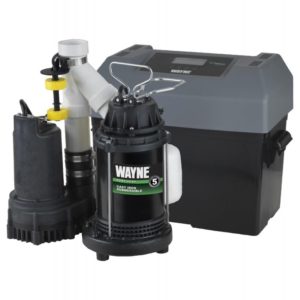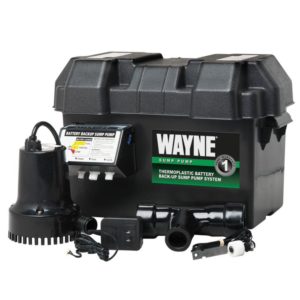 Whenever we’re asked by homeowners (usually in the middle of a sump pump installation) whether or not we recommend backup sump pumps, our answer is always the same: yes, and they’re far more affordable than cleaning up flooded basements.For only a few hundred dollars beyond the cost of an AC sump pump, you can buy a combination system where the DC pump kicks in when the AC pump stops working in a power outage. Our favorite combination systems for peace of mind include the Wayne WSSM40V (the best), the WSS30V (mid-range), and WSS20V (low-range). However, what do you do if you don’t need an AC sump pump and just need a bargain basement battery backup system?
Whenever we’re asked by homeowners (usually in the middle of a sump pump installation) whether or not we recommend backup sump pumps, our answer is always the same: yes, and they’re far more affordable than cleaning up flooded basements.For only a few hundred dollars beyond the cost of an AC sump pump, you can buy a combination system where the DC pump kicks in when the AC pump stops working in a power outage. Our favorite combination systems for peace of mind include the Wayne WSSM40V (the best), the WSS30V (mid-range), and WSS20V (low-range). However, what do you do if you don’t need an AC sump pump and just need a bargain basement battery backup system?
This is where the Wayne ESP15 Battery Back-Up 12 Volt Sump Pump System. It’s the lower-end version of the ESP25, which we’ve reviewed and liked in the past. For around $150, or the cost of a decent primary sump pump like the CDU800, you can buy a battery-powered backup sump pump to keep your basement dry when your main AC sump pump stops in a power outage. But how does the ESP15 compare to its larger sibling the ESP25? We figured we’d take an in-depth look. If you’re wondering whether it’s worth it or whether to spring for the ESP25, we’d recommend you spend the extra dollars and buy the ESP25 unless you were on a very tight budget, in which case, yes, we’d cautiously recommend the ESP15, which you can buy here.
Key Features of the Wayne ESP15 Sump Pump (60 Second Summary)
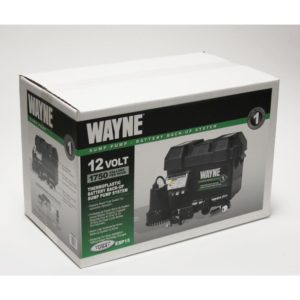 The Wayne ESP15 is a battery backup submersible sump pump system. The pump is DC-powered and features a 12 volt motor. It features a 1,750 gallon per hour maximum water flow rate and a 1 year limited warranty . It’s just under 11″ tall, 9.3″ wide, and 9.3″ deep with a maximum pumping height of 15 feet and a switch-on/switch-off height of 4″ and 9″ respectively. The aforementioned pump switch is vertical.
The Wayne ESP15 is a battery backup submersible sump pump system. The pump is DC-powered and features a 12 volt motor. It features a 1,750 gallon per hour maximum water flow rate and a 1 year limited warranty . It’s just under 11″ tall, 9.3″ wide, and 9.3″ deep with a maximum pumping height of 15 feet and a switch-on/switch-off height of 4″ and 9″ respectively. The aforementioned pump switch is vertical.
The ESP25 doesn’t use AC; it’s a DC battery backup, although the battery isn’t included; you’ll need a 12 volt deep cycle battery with either 40 amp hours or 75 amp hours. It weighs 9 pounds. Although the discharge flow can reach 1,750 gallons per hour at 0 feet, it drops to 720 gallons per hour at 10 feet, 300 gallons per hour at 15 feet, and is inoperative at 20 feet.
The working temperature spans 40-120 degrees Fahrenheit, it’s self-priming and housed in thermoplastic, and the sump pump outlet diameter is 1-1/2″ FPT. It’s designed to be used with sump pits (sump basins) at least 15 inches in diameter.
How Does the Wayne ESP15 Compare to the ESP25 Sump Pump?
The biggest differences between the ESP15 and the ESP25 have to do with power; to put it simply the ESP15 is a much weaker sump pump than the ESP25 at all ranges. At zero feet it pumps a max rate of 1,750 gallons per hour vs 3,300 in the ESP25; at 10 feet it’s 720 gph vs 2,300 gph; at 15 feet it’s 300 gph vs 1,500 gph. To put it simply, the ESP25 pumps more water close to its weakest point than the ESP15 does under ideal conditions. On top of this, it also comes with a warranty half as strong at 1 year instead of 2.
Our Short and Long Term Experiences Installing and Using the Wayne ESP15 Sump Pump
Installation was straightforward and took less than half an hour (keeping in mind we do this for a living). The included instruction manual wasn’t bad, but it was rather general and had a number of details that weren’t necessarily tied to the ESP15; we’d recommend using it as a reference and not worrying so much if certain facts differed.
Because it’s a backup pump, it’s ideally not one you’ll hear except for in emergencies (i.e., when your AC pump stops working due to a power outage and the rain won’t stop falling in sheets outdoors). However, we’re happy to note it’s a quiet little pump and isn’t likely to bother anyone while working, although it’s important to note that an alarm does sound whenever it’s functioning (which is good, since the battery won’t last forever). The primary flaw with the ESP15 is that it’s a rather weak pump, especially compared to the ESP25; we tested both pumps side by side by running a garden hose into the sump pump basin and disabling AC power to put the DC pumps to work. While both pumps were capable of keeping up with the water we ran, the ESP15 had to run for 2-3x as long each time in order to keep the water levels under control. This translates into 2-3x the battery drain in an emergency situation, and it made us wary of recommending the ESP15 over the ESP25 when the latter was so much more efficient while costing less than $100 more.
Troubleshooting and Installation Tips to Get Your Wayne ESP15 Working Sooner
The main thing to note with the ESP15 is that you need a 12 volt deep cycle battery attached for it to work; even though it’s connected to AC power due to the need to charge said battery, it’s not going to work if you lose AC power if you don’t have the battery attached (and this is when you’ll need it to work the most). You’ll want to choose either a 40 or 75 amp battery; if you try to use a larger battery, you might not get it to fit in the battery box. You need a 27-frame sized battery.
We’d also recommend you skip a regular check valve for the ESP15 and invest in a silent check valve; even though the ESP15 is already a very quiet sump pump, the “thunk!” sound that accompanies traditional hammer check valves will still be audible, and a silent check valve is the easiest way to get rid of it. The Brady check valve is a cheap and highly effective model. And yes, it’s definitely a silent model.
Finally, it’s a good idea to have a separate water alarm installed. You don’t have to go out and buy the most fancy one; a basic model like the Basement Watchdog will do. What’s important is to install it in your sump pit a bit higher than the backup float switch; this will trigger it if your DC pump either doesn’t start, stops working, or can’t keep up with the water (a risk with the ESP15); if you hear the water alarm sensor, you’ll know you need to visit your basement.
Wayne ESP15 Sump Pump’s Pros, Cons, and Value Comparison
In conclusion, we find it hard to recommend the ESP15 in a world where the ESP25 exists. For less than $100, it’s possible to get a pump that works at least 2-3x more efficiently than the ESP15, both increasing the odds that it will be able to keep up with heavy flooding (and keep such flooding outside your basement) while increasing the odds that your AC power will come back before your battery runs out. We’d only recommend the ESP15 if you absolutely couldn’t afford the ESP25; the latter will do a much better job and comes with literally twice the warranty coverage.
If you want the best DC backup sump pump on the market, we’d recommend going all the way to the WSM3300; it’s not only faster than the ESP25, it’ll also perform self-tests and has the capacity to call a range of numbers whenever it detects a problem. Alternatively, if you’d like an all-in-one system combining the ESP25 and a good AC sump pump (the CDU800), we’d recommend the WSS30V combination sump pump.
You can buy the Wayne ESP15 battery backup sump pump here on Amazon. You can buy the Wayne ESP25 backup here. You can buy the Wayne WSM3300 backup here. You can buy the Wayne WSS30V combination sump pump here. You can buy a 75Ah backup pump battery here. You can buy a water alarm here. You can buy a silent check valve here.
 If you find our work at PumpThatSump helpful, you can put our relentless reviewing of every pump and fixture on the market to the test by shopping via our links above for whatever you need to make your house a home. Despite being self-employed, we promise not to spend it all on health insurance.
If you find our work at PumpThatSump helpful, you can put our relentless reviewing of every pump and fixture on the market to the test by shopping via our links above for whatever you need to make your house a home. Despite being self-employed, we promise not to spend it all on health insurance.
